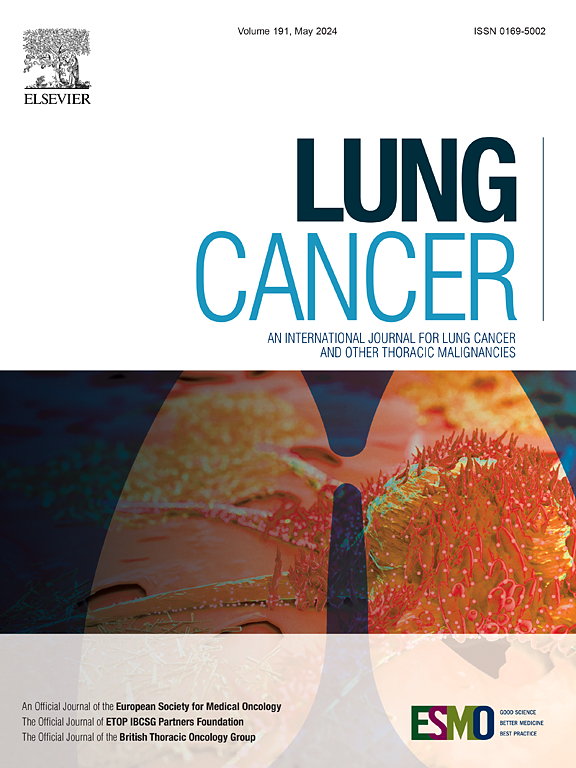奥西替尼联合安洛替尼作为EGFR突变晚期或转移性NSCLC患者的一线治疗:一项前瞻性单组探索性研究
IF 4.5
2区 医学
Q1 ONCOLOGY
引用次数: 0
摘要
作为EFGR突变(EGFRm)晚期NSCLC (FLAURA2)的一线(1L)治疗,奥西替尼加化疗可显著改善PFS。为了减轻化疗的细胞毒性和不便,我们探索了一种无化疗的口服联合治疗奥西替尼(osi)和安洛替尼(anlotinib,一种抑制肿瘤血管生成和生长的多靶点TKI)。方法本研究为前瞻性、单组、探索性研究。纳入了Treatment-naïve EGFRm晚期NSCLC患者(pts)。A部分在安全性和耐受性数据评估的基础上,评估了奥西替尼+安洛替尼联合使用的推荐剂量,以进行进一步的临床评估(A部分:osi, 80mg每日;每日8mg/10mg/12mg, D1-14, 21d/周期)。B部分是扩展队列。主要终点是推荐的2期剂量(RP2D) (A部分)和客观缓解率(ORR) (B部分)。结果入选25例符合条件的患者。RP2D为奥希替尼80mg,每日一次和安洛替尼(口服12mg /天,连续14天,休息7天)。24例(96.0%)患者出现了任何原因(TEAE)和任何级别的不良事件。8例(32.0%)患者发生3级TEAE。严重不良事件4例(16.0%)。在FAS人群中(定义为接受至少一剂研究药物的患者),ORR和DCR分别为60.0%(15/25患者,95% CI, 38.7%-78.9%)和88.0%(22/25患者,95% CI, 68.8%-97.5%)。中位PFS和OS分别为31.5个月(95%CI, 17.9个月- ne)和未达到,36个月PFS和OS率分别为31.9% (95%CI, 17.3%-58.8%)和74.3% (95%CI, 58.5%-94.4%)。结论索莫替尼联合全剂量安洛替尼安全性可控,疗效令人鼓舞,值得进一步研究。本文章由计算机程序翻译,如有差异,请以英文原文为准。
Osimertinib combined with anlotinib as first-line treatment in advanced or metastatic NSCLC patients with EGFR mutation: a prospective, single arm, exploratory study
Introduction
Osimertinib plus chemotherapy significantly improved PFS as first-line (1L) treatment in EFGR mutated (EGFRm) advanced NSCLC (FLAURA2). To mitigate the cytotoxicity and inconvenience of chemotherapy, we explored a chemo-free oral combination therapy with osimertinib (osi) plus anlotinib (anlo, a multi-targeted TKI inhibit both tumor angiogenesis and growth) in 1L setting.
Methods
This is a prospective, single arm, exploratory study. Treatment-naïve patients (pts) with EGFRm advanced NSCLC were enrolled. The part A assessed the recommended dose of the combination of osimertinib plus anlotinib for further clinical evaluation based upon assessment of the safety and tolerability data (Part A: osi, 80mg daily; anlo, 8mg/10mg/12mg daily, D1-14, 21d/cycle). Part B was an expansion cohort. Primary endpoint was recommended phase 2 dose (RP2D) (Part A) and objective response rate (ORR) (Part B).
Results
25 eligible patients were enrolled. The RP2D is osimertinib 80mg, once daily and anlotinib (12 mg/day orally, 14 days on and 7 days off). Adverse events of any cause (TEAE) and any grade was observed in 24 (96.0%) patients. 8 (32.0%) patients experienced grade 3 TEAE. Serious adverse events were reported in 4 (16.0%) patients. In FAS population (defined as patients who received at least one dose of study drugs), ORR and DCR was 60.0% (15/25 patients, 95% CI, 38.7%-78.9%) and 88.0% (22/25 patients, 95% CI, 68.8%-97.5%), respectively. Median PFS and OS were 31.5 months (95%CI, 17.9 months-NE) and not reached, respectively, with 36 months PFS and OS rate were 31.9% (95%CI, 17.3%-58.8%) and 74.3% (95% CI, 58.5%-94.4%), respectively.
Conclusions
Osimertinib combined with full dose anlotinib showed manageable safety profile and encouraging efficacy, deserving further investigation.
求助全文
通过发布文献求助,成功后即可免费获取论文全文。
去求助
来源期刊

Lung Cancer
医学-呼吸系统
CiteScore
9.40
自引率
3.80%
发文量
407
审稿时长
25 days
期刊介绍:
Lung Cancer is an international publication covering the clinical, translational and basic science of malignancies of the lung and chest region.Original research articles, early reports, review articles, editorials and correspondence covering the prevention, epidemiology and etiology, basic biology, pathology, clinical assessment, surgery, chemotherapy, radiotherapy, combined treatment modalities, other treatment modalities and outcomes of lung cancer are welcome.
 求助内容:
求助内容: 应助结果提醒方式:
应助结果提醒方式:


